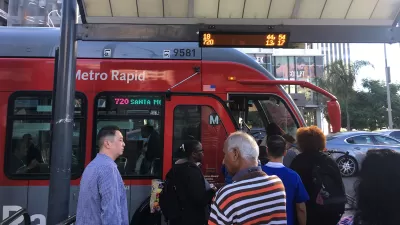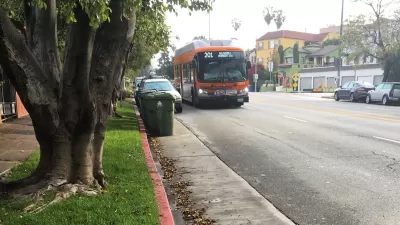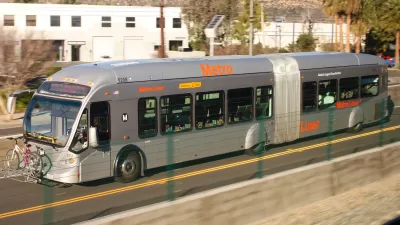Can Los Angeles convince drivers to cut the number of automobile trips in half while also transit frequency on several light rail lines?

Elijah Chiland reported at the end of April on an announcement of a "Green New Deal" by Los Angeles Mayor Eric Garcetti that sets a goal "to reduce the amount of driving in LA by nearly 50 percent in the next three decades."
Right now, LA drivers journey an average of 15 miles per capita per day, according to a report on the initiative released [in April]. That amounts to nearly 60 million miles driven per day within city limits.
Under Garcetti’s proposal, that would come down at least 13 percent by 2025 and 45 percent by 2050—a difference of more than 25 million miles each day, or 6.75 miles per person, should LA’s population stay relatively constant during that time.
Mayor Garcetti intends to achieve these ambitious goals by implementing safety improvements and streetscape projects already underway. Some experts are skeptical the city can achieve these goals, according to Chiland. "Juan Matute, deputy director of the UCLA Institute of Transportation Studies, tells Curbed the mayor’s goals are admirable—but won’t be easy to attain."
In Matute's own words: "Nothing that’s listed here will produce more than a 5 percent reduction […] It probably won’t bring them anything."
The actions of the regional transportation authority are already proving Matute's point about the difficulties of delivering on promises to cut driving. Since that announcement, the Los Angeles County Metropolitan Transportation Authority has decided to cut transit service on several of the region's light rail and high frequency bus lines, as reported in a much more recent article also by Chiland.
Metro’s Board of Directors [recently] approved a proposed $7.2 billion budget for the coming fiscal year, which begins in July. The financial plan includes a nearly 6 percent reduction in rail service hours, with the largest cuts planned on the Expo, Gold, and Blue lines. The change will result in fewer delays, according to Metro.
Chiland also notes that the board's action this week will also cut 75,000 hours of service from Metro's high frequency bus lines.
FULL STORY: Metro will scale back rail service, making for longer wait times

Planetizen Federal Action Tracker
A weekly monitor of how Trump’s orders and actions are impacting planners and planning in America.

Map: Where Senate Republicans Want to Sell Your Public Lands
For public land advocates, the Senate Republicans’ proposal to sell millions of acres of public land in the West is “the biggest fight of their careers.”

Restaurant Patios Were a Pandemic Win — Why Were They so Hard to Keep?
Social distancing requirements and changes in travel patterns prompted cities to pilot new uses for street and sidewalk space. Then it got complicated.

Platform Pilsner: Vancouver Transit Agency Releases... a Beer?
TransLink will receive a portion of every sale of the four-pack.

Toronto Weighs Cheaper Transit, Parking Hikes for Major Events
Special event rates would take effect during large festivals, sports games and concerts to ‘discourage driving, manage congestion and free up space for transit.”

Berlin to Consider Car-Free Zone Larger Than Manhattan
The area bound by the 22-mile Ringbahn would still allow 12 uses of a private automobile per year per person, and several other exemptions.
Urban Design for Planners 1: Software Tools
This six-course series explores essential urban design concepts using open source software and equips planners with the tools they need to participate fully in the urban design process.
Planning for Universal Design
Learn the tools for implementing Universal Design in planning regulations.
Heyer Gruel & Associates PA
JM Goldson LLC
Custer County Colorado
City of Camden Redevelopment Agency
City of Astoria
Transportation Research & Education Center (TREC) at Portland State University
Camden Redevelopment Agency
City of Claremont
Municipality of Princeton (NJ)





























